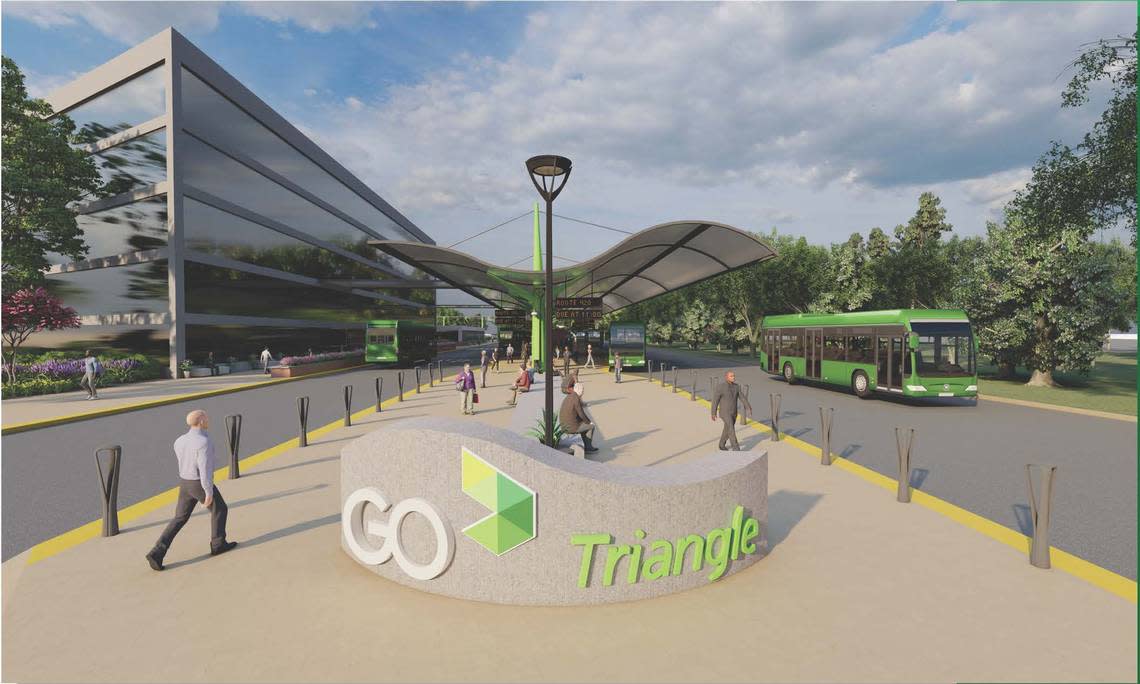Built for cars, Research Triangle Park will have its first hub for buses, maybe trains

In the 1990s, transportation planners picked a wooded lot on the edge of Research Triangle Park to build a station for buses and commuter trains.
More than 25 years later, the trees are all still there.
But now GoTriangle, the regional bus system, has received $25 million from the federal government to help build a new station on the land, near the corner of N.C. 54 and South Miami Boulevard.
The station, which GoTriangle calls the Triangle Mobility Hub, will replace the agency’s bare-bones transfer center carved out of a parking lot about a mile and a half away. GoTriangle hopes to begin using the station by the end of 2028.
This transit hub will help the Research Triangle Foundation fulfill its vision of turning RTP into more of a 24-hour place, rather than a suburban office park that everyone leaves each afternoon. The foundation owns the 19-acre site and will seek to rezone the land around the station for a more urban mix of apartments, restaurants and offices.
The land also abuts the main rail line between Raleigh and Durham and is considered a potential stop for commuter trains someday. The foundation, which manages the 7,000-acre park, is also urging Amtrak and the state to add a stop at the site for the Piedmont, the train that makes four daily round trips between Charlotte and Raleigh, said Travis Crayton, the foundation’s vice president of planning and public policy.
“We do see future Amtrak Piedmont service to RTP as very complementary to this,” Crayton said.
RTP will look different in the future
Established in 1959, Research Triangle Park was built for cars. Workers follow wide boulevards or tree-shaded two-lane roads to isolated office buildings surrounded by acres of parking.
It’s been wildly successful. More than 375 companies and government agencies have offices and labs in the park, helping transform the region’s small southern cities and towns into one of the country’s high-tech centers.
But the future of development for tech companies is increasingly urban, more like Raleigh’s North Hills or a traditional downtown than suburban corporate campuses. The Research Triangle Foundation has developed a blueprint it calls RTP 3.0 and will soon ask Durham and Wake counties to rezone the entire park to allow denser development that mixes retail, offices and homes, Crayton said.
“Landowners will have more options to choose from and be able to develop more mixed-use environments that still support our core research and development mission but that really allow us to create a much more live-work-play environment,” he said.
The model is HUB RTP, a 100-acre development between N.C. 54 and Interstate 40 that the foundation considers the park’s downtown. In addition to labs and offices, HUB RTP will have restaurants, shops, a hotel and hundreds of apartments around outdoor spaces that make it easy to traverse on foot.
The Triangle Mobility Hub will be about a mile from HUB RTP, which is not located on the railroad line. Transit riders will be able to reach the park’s downtown by shuttle or GoTriangle’s free rideshare program.
The station will have covered boarding bays for bus riders and drop-off spaces for shuttles and rideshare vehicles. It’s expected to cost about $58 million. In addition to the $25 million awarded this summer, GoTriangle will use a previous $5.5 million federal grant, while the local congressional delegation seeks $9 million more. The rest would come from the half-cent sales taxes that Wake, Durham and Orange counties collect for transit.
About 1,200 people a day pass through GoTriangle’s existing transit center near RTP, some to catch a shuttle to Raleigh-Durham International Airport. The center, off Slater Road, is an easy walk to GoTriangle’s headquarters building but little else, said Charles Lattuca, the agency’s president and CEO.
“Nothing’s walkable, unless you work at the Sheraton or one of those offices around there,” Lattuca said. “So the new location is going to be a much better area.”

